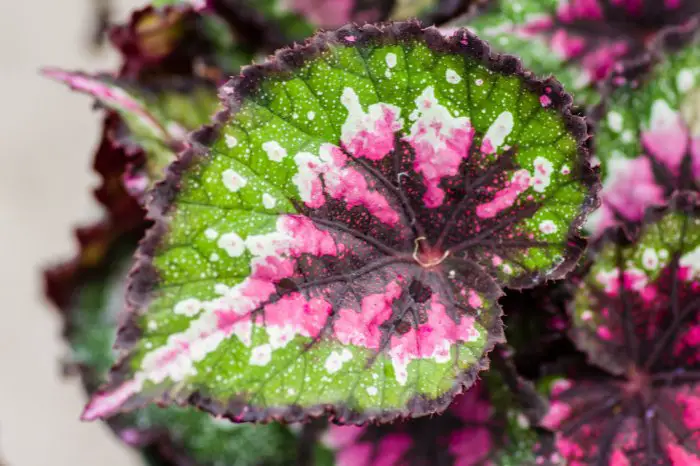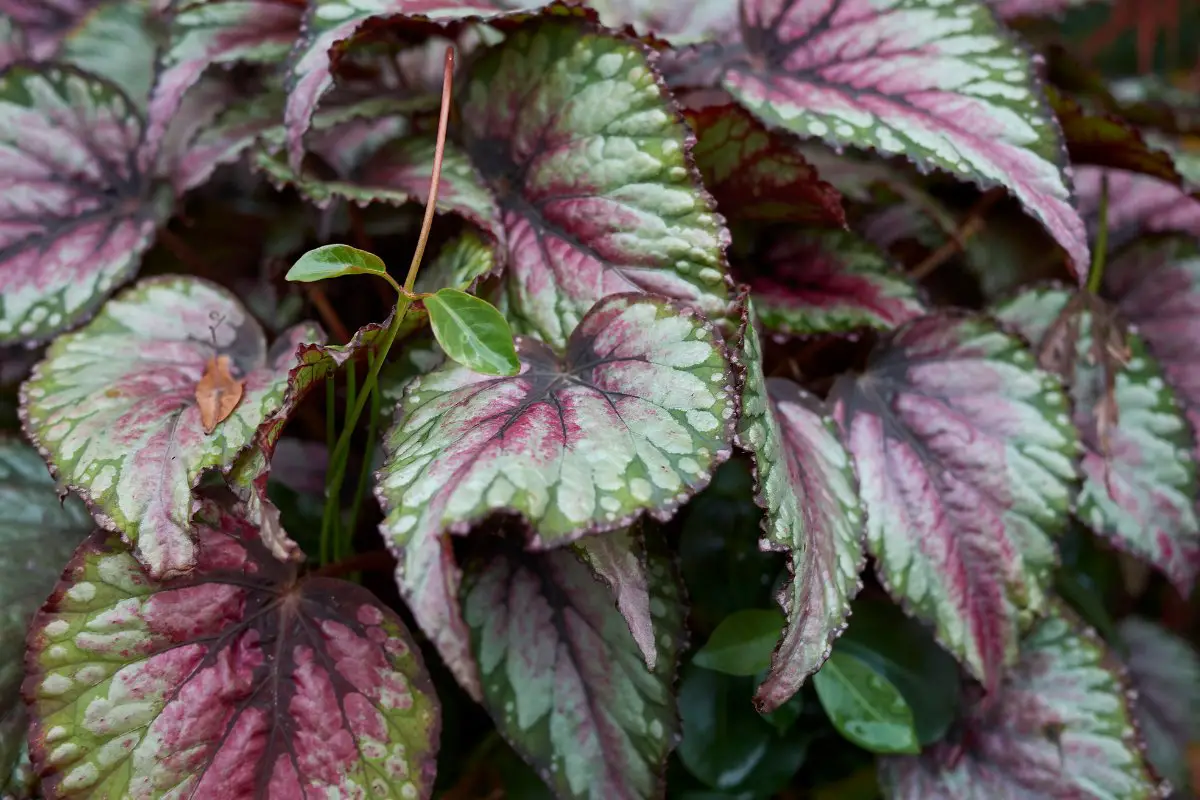Last Updated on January 4, 2023 by Cristina
The King Begonia – or Begonia rex, is a commonly cultivated plant with beautiful leaves. There are many types of rex begonias, and choosing a suitable cultivar, or cultivars will help you to create beauty in your home or garden. Let’s have a look at some of the common types of rex begonias.
What Is A Rex Begonia?
Begonia rex is a species of flowering plant native to parts of Northern India and China. It has particularly beautifully patterned fleshy leaves. This has led to intense interest in this plant by breeders who have bred thousands of different cultivars of this plant. In terms of the types of rex begonia, each cultivar has unique patterns, and often leaf shapes and bright colors. The plants are quite hardy and make excellent indoor and outdoor plants if you follow a few basic rules.
How Big Do Rex Begonias Get?
Generally, a begonia rex is not a particularly big plant, and it is easy to trim into shape. However, if you give it deep soil in a garden setting, the right cultivar can get to 5-6 feet high – especially if it has something to lean on. This is an exception, and generally, you can find Types Of Rex Begonias cultivars to fit the size constraints of the area you wish to plant in. Smaller pots also give smaller plants, so you can control height to a certain degree this way.

Rex begonia has rhizomatous roots – this means that the root is basically a stem that creeps along just below the soil in the mulch layer. Not only do they have a vertical dimension, but they also have a horizontal dimension – and they can migrate along the length of a large planter, or in the case of a garden, given a few years, they can start to take over a bit. When they take over too much they get a bit crowded and look sub-optimal.
Click Here to Get Info About:
Rex Begonia Light Requirements – Types Of Rex Begonias
Rex begonias need sunlight – but not too much direct sunlight. If you look at a leaf, and the logic of a leaf, its function is to absorb sunlight and convert this to sugar. It does this with chloroplasts, which, due to their light absorption capacity, reflect green, capture other frequencies of light, and use this energy to drive the photosynthesis process making sugar. Humans tend to like bright colors – wild Begonia rex plants have slightly creative leaf patterns. We have bred them to have utterly insane leaf patterns where a significant portion of the leaf is actually just decoration, and a little bit is photosynthetic.
If we understand that the more wild the leaf color is (as in the less green it is) the less the plant can tolerate direct sunlight, but the longer it needs indirect sunlight so that it can photosynthesize with the little bit of useful leaf we have left it with. In this regard, I do advise that if you live in a part of the world where days get short (under 8 hours of sunlight) it is definitely a good idea to invest in some supplemental lighting for your Rex begonias. If you give them three or four more hours a day of light they will thrive. If you feel generous give them a few more and they will thank you for that. This will stop them from going dormant in winter.
So in summary, in terms of types of rex begonias, the wackier the leaf pattern, and the less green it shows, the more you need to extend the length of time it receives light.
Begonia Varieties Indoor Tolerance Characteristics
There are thousands of rex begonia cultivars, and these have been bred by dedicated breeders around the globe. What I love about this sort of thing, is that you get some person working in their garden cave in a cold winter somewhere, fiddling around with plants, and POW, they come up with a cultivar that grows really well in Maryland, in the winter on a table in an apartment with lighting – but this same plant may be a disaster in Los Angeles! This is always why I advocate locally adapted plants, bees, seeds, and so on. Life forms adapt to their local conditions, and with our help, they adapt faster.
Fertilome 11722 All Purpose 20-20-20 Water Soluble Plant Food – 3 lbs.
If we look at Himanchal Pradesh, one of the regions of India where Begonia rex is indigenous, the environment is moderate in the valleys with temperatures ranging from 50°F in winter to as high as 95°F in summer. The plants will be exposed to a more stable temperature range in an indoor environment in the US for example where houses average about 68-76°F. The plants will however be exposed to low humidity for some times of the year and I would recommend a humidifier in such environments. Ideally, you need the humidity not to drop below 50% and smart humidifiers allow you to control this from your smartphone. If you keep the humidity level above 50% and temperatures in the 60-75°F range, most types of rex begonia will thrive.
In my personal experience, I went and had a look at my collection of plant tags. In terms of indoor begonia rex varieties I have grown, it appears I have grown Planted Egg (did well), Planted Arizona (did well, but cat destroyed it), Plantimex Begonia (did really well, put it in the garden, became a weed and got rid of it), and planted Windsor (grew well for a few years and vanished – may have died when I was working overseas for a while during COVID and got stuck away from home due to lockdown). I have been through my begonia stage and enjoyed it but am now focussing on plants indigenous to my area, and things I can eat.
Take Out Time to Also Read:
How To Choose Begonia Rex Varieties
This is a bit like suggesting what wine you would like, or food you should eat! Depending on what information you read, there are somewhere between 1000 and 4500 cultivars of rex begonia out there. There are a lot of types of rex begonias. Some of these form seeds, and if these germinate, every seedling is a new variety and will have new leaf patterns. So in reality there are probably tens of thousands or more different leaf patterns out there!
My suggestion is simple – go to a nursery and look around. If you see a begonia rex that appeals to you, buy it!! Read the tag naturally to see what its light requirements and space requirements are. This is what I did – I was at a local shop and was enamored with the leaf colors and just bought the cultivars I listed earlier. It was great – they are a bit like guppies in a fish tank – you love them for a few years, and then move on. Well for me that was the case. Some people seem to get addicted to them for life.
You will always find local nurseries are a source of great knowledge. Many nurseries now have tea/coffee gardens. Somewhere in a corner, there will be a senior citizen. Spend some time chatting with them. They may not even work in the nursery, but they have been around for a while. They have the knowledge, and asking a retired person for their knowledge is the greatest form of respect we can pay to the fact that someone has learned for that amount of time. I find that retired people are my go-to source of information on plants – they have survived 65 years minimum and have a lot of wisdom and stored knowledge built up about what grows when and how. And there is a strong urge to share knowledge before it vanishes forever that we often do not understand until it is too late.
In Conclusion – Choosing Types Of Rex Begonias
There are thousands of types of rex begonias that have been bred by avid breeders, and sometimes wombat breeders who just make a mistake that looks awesome. These cultivars can be adapted to a specific climate or adapted to be good indoor plants. It is really difficult to list the ones you should grow, as I actually probably have no idea about where you live, and what the conditions are where you live.
I would suggest you go to a local nursery and just have a look around. These plants are all stunning, and the one with the color pattern and leaf shape that works for you will jump out at you. Choosing a begonia rex with a nice leaf pattern that appeals to you is a bit like taking a Rorschach test. You may find a leaf pattern appeals to your inner peace and reminds you of a waterfall in a forest, but somebody else finds it reminds them of their drunk uncle going crazy with a knife. Choosing a begonia rex is a personal thing.
Dr. Garth A. Cambray is a Canadian/South African entrepreneur and beekeeper with 28 years of experience in apiculture and specializes in adding value to honey. His Ph.D. research developed a new advanced continuous fermentation method for making mead that has resulted in a number of companies globally being able to access markets for mead. His company, Makana Meadery, exports honey mead to the USA where it is available to discerning connoisseurs. He has also developed technologies to commercially manufacture organic honey vinegar in Zambia for export globally. He holds a few patents globally in the ethanol industry and believes in technology and knowledge transfer for human development and environmental sustainability. One of his proudest achievements is the fact that the wind farm he started at one of his old apiary sites has essentially made his hometown carbon neutral.



